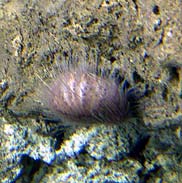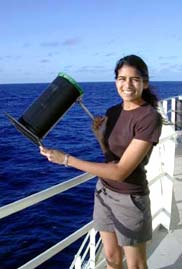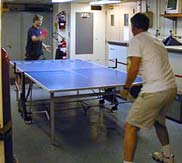April 25, 2003 -- Almost There!
Mausmi Mehta
|
|
|
|
|
|
|
|
|
| Sun |
Mon |
Tue |
Wed |
Thu |
Fri |
Sat |
|
|
 |
|
Q. Are the chimneys stone or organic?
A. A great question, which we do not yet fully know the answer to yet. We know that the chimneys are made out of the same minerals that make up the rock (or stone) called limestone. Limestone is composed of minerals made out of calcium carbonate (e.g. calcite). Some organisms can actually help calcite to crystallize. But, we do not yet know if this is happening at the Lost City Field
Q. Do you really think there is life down there in the Lost City? (From Cambridge Springs Elementary, PA)
A. Life at a small scale is incredibly abundant at Lost City. Small, single celled organisms coat actively venting parts of the chimneys and life within small openings in the rocks. Larger animals such as mussels, sea anemones, and sea urchins live near or on the structures. There are also very large corals and fish that live there.
|
 |
|
 |
|
|
|
|
|
 |
We awoke on our fifth day of transit to slightly rougher seas, but the sun was still out and the sky was still blue. The weather made playing ping pong (a favorite on the ship) a little more challenging.
All of the scientists eagerly anticipate arriving on site tomorrow afternoon. At science meeting today, Gavin introduced us to Alvin's extensive video systems and explained what the responsibilities of each observer are. We then heard from Tim Shank, an evolutionary biologist, about some of the macrofauna that we might expect to see at Lost City. It doesn't appear to be densely populated with animals like mid-ocean ridge (MOR) hydrothermal vents often are, at least as far as we know. But there are many different kinds of corals and sponges, and even some amphipods, soft urchins, pink shrimp, nematode and polychaete worms.
 |
|
A sea urchin
|
Then Dave Butterfield told us about the chemistry of the hydro-thermal fluids at Lost City. Since he only had three fluid samples from 2000 to work with, he will be learning a lot more from the samples we take during this cruise. One of the key chemical characteristics of Lost City fluids are that they have very high pH, compared to the acidic fluids from mid-ocean ridge hydrothermal vents. There also appears to be some hydrogen sulfide present, which is very important for microbes at MOR hydrothermal ecosystems.
 |
|
Mausmi holds the in-situ colonization experiment
|
The microbiologists on board (Billy Brazelton and myself) are all set up and awaiting the first rock and fluid samples from Lost City. We will be preserving samples in order to count the number of cells and use microscopic techniques to determine whether they belong to the Bacteria or the Archaea. We will also be freezing samples to extract DNA and RNA once we are back on land, and we can use the DNA to figure out exactly what kinds of micro-organisms are present in the sample. One of our main shipboard activities will be trying to grow microorganisms from Lost City in tubes that we have added growth media to, at various temperatures ranging from room temperature to 90 degrees Celsius. Finally, we have two in-situ colonization experiments, devised by Matt Schrenk, which we will deploy in diffuse flow and fill with different kinds of rocks. The set-up allows for the flow to continue through the chamber past the rocks, and we will recover the experiments a few days later, hopefully with lots of microbes growing on the rocks.
 |




